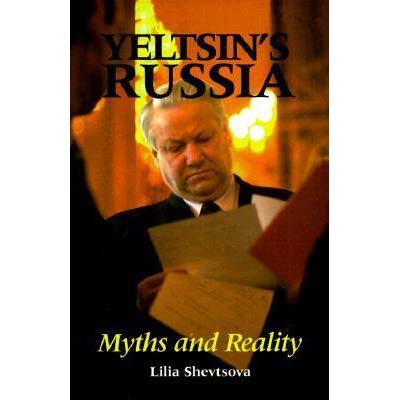
People interested in an account of the Yeltsin era should turn to Lilia Shevtsova: Yeltsin’s Russia: myths and reality. Carnegie Endowment book, Washington, 1999, 345 S. Amazon.com, Amazon.co.uk.
Book review
Shevtsova, a political analyst at the Moscow Carnegie Center, has written the first comprehensive account on Yeltsin’s years in power 1989-99, based on newspaper articles and political science studies. On the positive side, Shevtsova notes Russia’s political stability since the end of the USSR. There has been no social unrest yet. The political system has not been challenged either. But the silence is largely due to the people’s disillusionment and the lack of alternatives. Most Russians are occupied with mere subsistance problems. They cannot see a bright future for them and only 15% consider themselves economic winners of the new system.
According to Shevtsova, the communists are still the best organized political power. But they have done almost everything they could in order not to come to power again. They are comfortably installed in their postion as opposition force where they do not have to share any responsibility. Ironically, the communists are largely responsible for Yeltsin’s years in power since they are such a frightening alternative that most people preferred Yeltsin to stay. The communists also bind a lot of dissatisfied people to them and, in doing so, hinder them from becoming more radical.
Yeltsin’s worst error is not having been able to establish strong democratic political institutions and solid rules for the political game. Shevtsova critizes his disrespect for the law and the demagogical behaviour he has used just in order to stay in power. His superpresidency, first seen as a factor of stability, has become the main problem of Russia, which has become an electoral-monarchy with a barter-economy. Part of the responsibility belongs to the early reformers. They dismantled old political and economic mechanisms and laid out the basis for new ones, but without any sensitivity for the social consequences of their actions and without any consideration for the needs of “the masses”. The reformers became an isolated group that progressively lost power and influence to conservatives, regional groups and industrial lobbyists, all better fighters than them. Shevtsova is not totally pessimistic and considers the younger generation of Russian politicians more capable of establishing a democratic and prosperous Russia.
Regarding the end of the USSR, the political analyst writes that the dynamic forces within the nomenclature became more and more disappointed with Gorbachev’s lack of decision-making, his lack of vision and his attempts to stay in power. They prefered Yeltsin in the end. The putsch of August 1991 shifted the balance of power from Gorbachev to Yeltsin. Shortly afterwards, the new strong-man shocked the democratic supporters – who were responsible for his victory. He forgot to include them in his new government. Only Galina Starovoitova and Sergei Stankevich remained on his side, but not as part of Yeltsin’s inner circle. It quickly became clear that he intended to get support from different groups with very different ideas that would constantly be involved in a power-struggle and would therefore neutralize each other. Yeltsin took regional groups, radical democrats, liberals, populists, neo-conservatives and technocrats into his team of 1991. He favoured conflicts between the governmental factions in order to be in the position of mediator and judge. Yeltsin took over the old style of Soviet government with the difference that he replaced the earlier principle of unanimity by the principle of loyalty towards himself.
Shevtsova reminds the readers of the fact that in the 1996-presidential elections, Yeltsin and his team seriously prepared the way for the invalidation of the results in case he lost power. On the positive side, she notes that the president never searchcd for conflict with the West and never supported aggressive political strategies towards neighbours like the Ukraine or the Baltic states. On the dark side are his wars in the Caucasus, especially in Chechnya. On the positive side again: he never tried to limit civil rights and the oligarchs did not become the decisive forces [yet?]. Shevtsova also reminds us of well-known facts about Russia such us the heritage of seventy years of communism and, before that, of the absolute monarchy, the lack of a middle class, the lack of an individualistic tradition and more. In her eyes, the years after Yeltsin will be decisive.
Shevtsova should have given more attention to the examination of the economic system and the oligarchs. She does not analyze the corruption and the Russian mafia. Some leaders like Primakov are not described. As a pioneer work, Yeltsin’s Russia is still a valuable source of information and easy to handle thanks to its chronological presentation and its index.
Lilia Shevtsova: Yeltsin’s Russia: myths and reality. Carnegie Endowment book, Washington, 1999, 345 S. Order the book from Amazon.com and Amazon.co.uk.